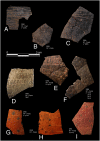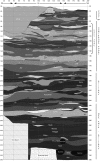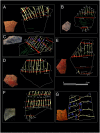From the Cover: A Howiesons Poort tradition of engraving ostrich eggshell containers dated to 60,000 years ago at Diepkloof Rock Shelter, South Africa
- PMID: 20194764
- PMCID: PMC2851956
- DOI: 10.1073/pnas.0913047107
From the Cover: A Howiesons Poort tradition of engraving ostrich eggshell containers dated to 60,000 years ago at Diepkloof Rock Shelter, South Africa
Abstract
Ongoing debates about the emergence of modern human behavior, however defined, regularly incorporate observations from the later part of the southern African Middle Stone Age and emphasize the early appearance of artifacts thought to reflect symbolic practice. Here we report a large sample of 270 fragments of intentionally marked ostrich eggshell from the Howiesons Poort at Diepkloof Rock Shelter, Western Cape, South Africa. Dating from approximately 60,000 years ago, these pieces attest to an engraving tradition that is the earliest reliable evidence of what is a widespread modern practice. These abstract linear depictions were made on functional items (eggshell containers), which were curated and involved in daily hunter-gatherer life. The standardized production of repetitive patterns, including a hatched band motif, suggests a system of symbolic representation in which collective identities and individual expressions are clearly communicated, suggesting social, cultural, and cognitive underpinnings that overlap with those of modern people.
Conflict of interest statement
The authors declare no conflict of interest.
Figures





Comment in
-
Cultural modernity: consensus or conundrum?Proc Natl Acad Sci U S A. 2010 Apr 27;107(17):7621-2. doi: 10.1073/pnas.1001458107. Epub 2010 Apr 21. Proc Natl Acad Sci U S A. 2010. PMID: 20410459 Free PMC article. No abstract available.
References
-
- Mc Brearty S, Brooks AS. The revolution that wasn’t: A new interpretation of the origin of modern human behavior. J Hum Evol. 2000;39:453–463. - PubMed
-
- Wadley L. What is cultural modernity? A general view and a South African perspective from Rose Cottage cave. Camb Archaeol J. 2001;11:201–221.
-
- Henshilwood CS, Marean CW. The origin of modern human behavior. Curr Anthropol. 2003;44:627–651. - PubMed
-
- Hovers E, Ilani S, Bar-Yosef O, Vandermeersch B. An early case of symbolism. Ochre use by modern humans in Qafzeh cave. Curr Anthropol. 2003;44:491–522.
-
- Chase PC, Dibble HL. Middle Palaeolithic symbolism: A review of current evidence and interpretation. J Anthropol Archaeol. 1987;6:263–296.
Publication types
MeSH terms
LinkOut - more resources
Full Text Sources

